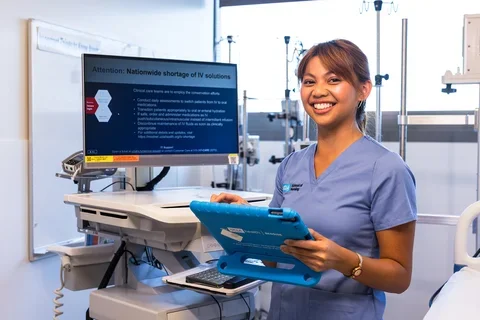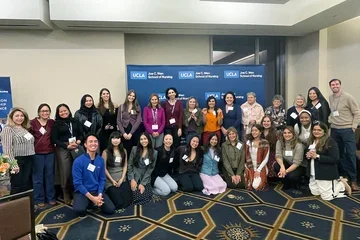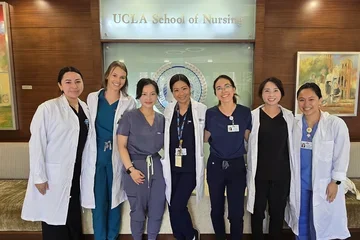A Healthy Partnership
The UCLA School of Nursing and UCLA Health Nursing have forged an academic/practice bond that uses integration, collaboration, and synergies to benefit patients, families, students, and communities

By any measure, the UCLA School of Nursing is a world leader in addressing the most critical healthcare issues of the day through groundbreaking research, community engagement, and educational programs that prepare the next generation of nurses at the baccalaureate, master’s, and doctoral levels. Likewise, UCLA Health Nursing is internationally renowned for its leadership in providing healthcare — whether it’s at the hospitals in Westwood and Santa Monica, community clinics, or sites throughout Southern California that reach some of the region’s most vulnerable populations.
But until recently, UCLA’s nursing school and UCLA Health’s nursing service have largely operated as separate entities, with little coordination — despite the fact that they share overarching goals and their leadership teams are a mere stone’s throw apart.
“In the past, there has been a disconnect between academic nursing and practice nursing,” says Dr. Lin Zhan, the UCLA School of Nursing’s dean. “In the traditional model, our contacts tended to be around finding clinical placements for students. But the nursing practice leaders didn’t necessarily know what our students were taught, or the competencies they graduated with.”
When Zhan arrived at the school in 2021, one of the first people she met with was Dr. Karen Grimley, chief nursing executive for UCLA Health and a kindred spirit when it came to the belief that a stronger academic/practice partnership could bring a multitude of benefits to both sides. “We have a shared goal,” Zhan explains. “As a school, we want to develop nursing science that supports innovation and evidence-based care, and to prepare nurses who are practice-ready and can help transform healthcare to be both accessible and just. UCLA Health Nursing is seeking the same outcome.”
Together, Zhan and Grimley have designed a framework for a strengthened academic/practice partnership. Their model aims to use integration, collaboration, and synergies to promote health equity, innovation, and excellence. At the center of these efforts are the partnership’s ultimate beneficiaries — patients and their families, students, and communities.
UCLA’s academic and practice nursing leaders are taking their cue from a national push, spearheaded by the American Organization for Nursing Leadership (AONL) and American Association of Colleges of Nursing (AACN). In 2023, the two organizations assembled practice leaders and nursing deans to capture key challenges and priorities facing the practice and academic worlds, and to determine how they could work together to better address them. The organizations identified five domains as part of their shared vision for integrating nursing education and practice: striving toward health equity, moving to competency-based nursing education, sustaining the supply of highly educated nurses, leading innovation to maximize nursing’s impact, and ensuring continuous advancement of nursing.
That vision of a stronger academic/ practice partnership has already begun to be realized at UCLA, starting at the highest levels. Grimley holds a position at the School of Nursing as assistant dean; in that role, she participated in the development of the school’s strategic plan. In turn, Grimley has moved to bring Zhan into UCLA Health Nursing leadership meetings. “This partnership between the dean and the chief nursing executive is rare nationally, and it has really helped to break down walls,” Grimley says.
One of the most consequential outcomes is that the school’s graduates leave with the clinical knowledge and skills UCLA Health Nursing seeks. “Often, changes in nursing care delivery take years to migrate into an evidence-based practice that would make it into the curriculum of a nursing school,” Grimley explains. “This partnership helps to ensure that the curriculum and practice of nursing remain current and state of the art.”
In conjunction with UCLA Health Nursing, the school has adopted AACN’s “The New Essentials: Core Competencies for Professional Nursing Education,” which establishes the clinical competencies nurses are required to demonstrate in order to practice. Newly graduated pre-licensure hires start in a residency program, strengthening their skills and knowledge through didactic and hands-on experiences under the supervision of a preceptor. “It’s a great benefit to know what they’re teaching next door, so that we are aware of what we’re getting when pre-licensure students come for their clinicals,” Grimley says. Along with providing input on the school’s curriculum, five UCLA Health Nursing leaders hold in-kind faculty positions in the school’s Doctor of Nursing Practice program, teaching and mentoring students’ scholarly projects, while other UCLA Health nurses teach in the Advanced Practice Registered Nurse master’s program and the Bachelor of Science program.
Beyond the clinical competencies, Zhan and Grimley see the academic/ practice partnership as an opportunity to educate students in ways that reflect current and future healthcare priorities and the evolving role of nurses in hospitals, clinics, and communities. They point to the growing emphasis on health promotion and disease prevention, and on the long-term management of chronic illnesses that many people now live with for decades. Zhan notes that more than ever, today’s nurses are considered partners with physicians, bringing not just their clinical know-how but also strengths in education, communication, and cultural sensitivity. “I share with our faculty that if you teach your students what you were taught, how can we prepare future nurse leaders?” Zhan says. “We want to prepare dreamers, thinkers, and doers — students who can question things and act as change agents.”
In the hospital rooms and clinics, Grimley has capitalized on the scholarly expertise of the UCLA School of Nursing faculty — inviting the school’s nurse scientists to conduct research in the practice setting that bolsters UCLA Health Nursing’s evidence base and quality of care; to mentor UCLA Health nurse scientists in their research; and to collaborate in introducing innovation to improve patient care. As a flagship of the research partnership, the UCLA Health Center for Nursing Excellence and the UCLA School of Nursing annually co-sponsor the UCLA Nursing Science & Innovation Conference — drawing nursing scientists, clinicians, educators, students, and leaders from across the country for a day-long event to raise awareness of new healthcare trends while supporting quality improvement, evidence-based practice, research, and innovation at the bedside. The most recent conference, held in May, featured more than 60 poster presentations from researchers, clinicians, educators, and students representing the UCLA School of Nursing and UCLA Health.
The academic/practice partnership also provides a myriad of opportunities for UCLA School of Nursing students to participate in impactful hands-on learning activities under the apprenticeship of UCLA Health nurses — not only in the hospital or clinic setting, but also in the community. Many of the school’s students are placed with UCLA Health’s Homeless Healthcare Collaborative, which provides free primary and urgent care services to people experiencing homelessness in Los Angeles via mobile clinics that visit streets and shelters, encampments, interim housing sites, libraries, and soup kitchens. Each year, UCLA School of Nursing students join with faculty, UCLA Health nurses, and others in volunteering at Care Harbor, which delivers free medical, dental, and vision care to uninsured, underinsured, and underserved individuals.
“It’s vital that our students understand that health is not just biological and physical; there are also social determinants,” Zhan says. “These learning opportunities with our practice partners are invaluable.”
Just as UCLA Health nurses enhance the education of UCLA School of Nursing students through these and other hands-on experiences, Grimley notes that the school can help strengthen UCLA Health Nursing’s approach to training its nurses through the teaching expertise of the school’s faculty. Toward that end, Grimley and Zhan have begun discussing ways to bring UCLA Health nurses and nursing students together for teaching and training activities at the UCLA Simulation Center. They point out that the center can also serve as a venue for increased interdisciplinary interactions involving students, faculty, and practitioners from UCLA Health and all of the health professional schools — nursing, medicine, dentistry, and public health.
Most valuable of all, Grimley says, “this partnership is enabling us to create a robust pipeline of newly graduated nurses who are well educated and prepared to succeed. It’s pretty great having the UCLA School of Nursing across the street.”



